“We’re clearly in the presence of two distinctly different bodies.”
You know, everyone talks about quantum superposition, but nobody does anything about it.
The scientific protocol is as follows: You put a vampire into a box, while the actor goes to Illinois and appears in Dial M for Murder. After four weeks, there’s a fifty-fifty chance that audience interest in the story has decayed.
While the mystery box is closed and the audience can’t observe the vampire directly, the storyline exists in two states simultaneously, a superposition of “dead vampire” and “alive vampire”. This is soap opera quantum mechanics. When you open the box, the two possible quantum states collapse into one, and the audience can observe whether the vampire is alive or dead.
The problem is that Edward Collins and Count Petofi have just opened the coffin, and there’s both a dead Barnabas lying in the coffin and an alive Barnabas collapsing on the cave floor. They’re supposed to choose one or the other; Schrödinger will be simply furious when he hears about this.
So here we are — at the peak of Dark Shadows’ ratings success, cresting the last great surprise before the show begins its long, gradual decline. In this moment, the show’s rising popularity meets its impending defeat; it is simultaneously a blockbuster hit and a soon-to-be-forgotten novelty.
It’s time for reality to collapse into one position or another — and on Dark Shadows, when things collapse, they really collapse.
This week, in schoolyards across the country, there’s basically one topic of conversation — is Barnabas alive or not? We saw Pansy the Vampire Slayer hammer a stake into the guy a month ago, and here he is, still stuck.
But yesterday, this mysterious lookalike showed up, staggering around in the woods. The new guy — who looks just like Barnabas, and calls himself Barnabas — claims that he’s a victim of his shadow twin, who kept him prisoner somewhere and fed off his life essence. This is a preposterous story that can only be understood if you have a doctorate in particle physics.
So the schoolyard argument about which Barnabas is the real one has been taken up by Edward and Count Petofi, who’s currently making a quantum leap of his own, and is appearing in the guise and garb of Quentin Collins.
Edward decides that box-Barnabas is the vampire, and therefore man-Barnabas wins an all-expense-paid trip to Collinwood.
Petofi: Are you crazy?
Edward: You heard this man’s story. He’s a Collins, and he’s been through a terrible experience.
Petofi: And you really believe him?
Edward: Don’t you?
Petofi: … I don’t know.
Edward: What other choice do we have? We’re clearly in the presence of two distinctly different bodies.
Petofi: But they look exactly the same!
Edward: But we have both seen that this man can exist in daylight, and we have seen that the stake is still in the heart of this vampire!
Count Petofi just stands there and fumes, and you have to feel sorry for the guy. He used to be the wonderful wizard in his underground lair, moving the chess pieces around as he constructed his dazzling master plan. Now he’s just another middle-schooler, who knows that this must be a trick, but can’t quite figure out how it was done.
And I can’t figure it out either, by the way. For most of the show’s run, I’ve understood how Dark Shadows used the limited technology that was available to them. They recorded the episodes live-to-tape, just turning the cameras on and running through the show like a stage play, leaving empty space for the commercials. Editing videotape was a luxury, so the special Chromakey effects were all done in-camera, mixing two live video feeds into one image. If an actor was needed on another set, then everybody had to stall while he ran across the studio. Showing the same person in two places at once was impossible.
Up until now, I’ve been able to explain almost everything that we’ve seen — that’s a Chromakey shot, that’s a stand-in, that’s a still picture — but recently they’ve been learning new tricks. There’s been a gradual increase in the amount of editing that they’re able to do, and there are moments like this one, where they’ve clearly upped their game. It’s essential to the Dark Shadows mission that the show maintains its capacity to surprise, and this one is rock solid.
The rest of the episode is basically a series of philosophical arguments about whether this is the same Barnabas or not, with Edward serving as the voice of reason, patiently explaining the least explicable explanation, while the mad fanatic Reverend Trask points out the obvious.
“He was in his coffin with a stake through his heart!” Trask cries.
“The man you are thinking about is still in his coffin,” Edward says, as if he’s already told you this a hundred times. “That is not the same Barnabas. He was victimized by the Barnabas we all know, and you can see, he is in a terrible state.”
Trask’s counter-arguments are: the Devil is at work here (which he is), he has deceived you (which he has), you have made a mistake bringing him into this house (which we have), and his presence here is a danger to all of us (which it is). The score is currently four-nothing for Trask, but Edward has a knockout blow.
“Trask, in all of your fanatical ravings,” Edward sighs, “there is one salient point which you have failed to grasp.”
“And what is that?”
“Quentin and I brought this man in here in broad daylight. Even you are supposed to know that a vampire cannot live during the day.”
This is a devastating putdown, because Trask has forgotten one of the fundamental principles of vampire science. What a maroon.
Upstairs in the guest room, Count Petofi tries a different angle. Edward may think this is the innocent daywalker, but Petofi is a realist, and he knows that somehow, the vampire has changed his spots.
The conversation goes something like this:
“Barnabas,” Petofi says, in a casual I’m-not-an-impostor way, “now that we’re alone, you don’t have to playact anymore.”
“Playact?”
“Believe me, it’s all right. I know the full story.”
“What full story?”
“I know that Angelique and Julia have been working together, to bring you back.”
“Angelique? Julia?”
“And now we can work together to fight Petofi.”
“Petofi? Fight?”
It’s marvelous; and all he has to do is repeat back phrases, and everyone else needs to come up with new material. Daytime Barnabas could do this in his sleep, which is pretty much what he’s doing.
Now, if his story actually is true, then just imagine the kind of life he’s been leading. He came here from England, with the hope of meeting some distant relatives. Instead, he’s set upon by his own ferocious evil twin, who drinks his blood and usurps his place in the family. Finally freed by some miracle, he shows up at the house, and everybody keeps throwing backstory at him.
This storyline is basically the superposition of the classic amnesia story and the evil twin story, two soap staples. If this was happening on a modern soap right now — and it probably is — then we’d spend the next three weeks discussing DNA test results.
But it’s hard to work up any sympathy for the newbie. This is what you get for looking like Barnabas. You should have thought of that before.
At this point, Schrödinger — unable to get the wave function to collapse — grows increasingly frantic. Alarms go off; grad students scramble. Schrödinger just starts smacking at the cat with his briefcase, desperately trying to get it to resolve into one state or another.
“As long as this thing exists, the family’s in danger,” Petofi says, setting the coffin alight. “You must admit that, Edward.” And Edward does, as he must, because preposterous premise has become fact. And the fire spreads.
And so the villain — who is himself a superposition of Count Petofi and Quentin Collins — invites a psychic — herself a quantum admixture of Charity Trask and Pansy Faye — to resolve the problem.
Meanwhile, the survivors at Schrödinger’s lab — each of them atomically decaying, observed and unobserved and impossible to predict — are being contained in a series of small boxes, each one equipped with a Geiger counter and a small flask of hydrocyanic acid.
And that cat — that unobservable cat, with its own theories about the Copenhagen interpretation — it lives and dies, in fractal patterns, visiting entangled decoherence on both the researchers and the researched-upon. There will be a collapse, Schrödinger demands. There must be. The cat leaps to the chalkboard, and writes an unfamiliar equation.
Tomorrow: The Collapsing Cat.
Dark Shadows bloopers to watch out for:
In the first act, when Edward points at the unconscious Barnabas, the camera tries to zoom in on Barnabas, but it’s completely out of focus.
When Pansy says she remembers her father, somebody coughs in the studio.
At the end of act 2, Trask storms out of Collinwood, vowing to go and ask Charles Delaware Tate who bought Amanda’s portrait. But when we see him in act three, he’s entering Barnabas’ guest room with a cross, and nobody mentions whether he actually talked to Tate or not.
Footnotes:
My favorite prop, the Ralston-Purina lamp, shows up today in the guest room that they put Barnabas in. The last time we saw it was in July, on the drawing room desk when Trask unwittingly signed his confession.
Tomorrow: The Collapsing Cat.
— Danny Horn

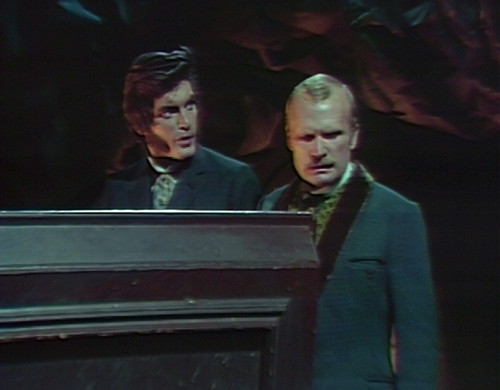
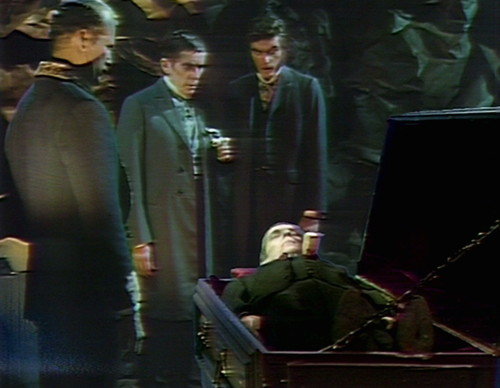
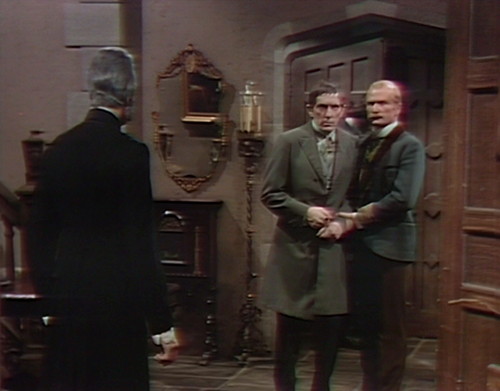
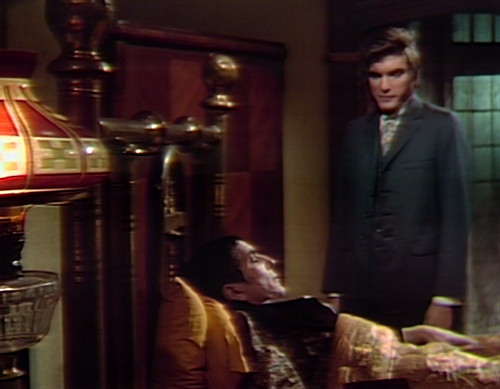

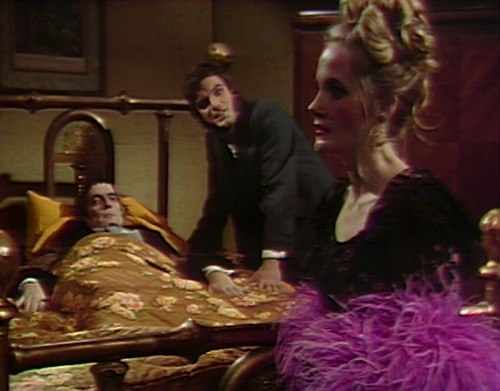
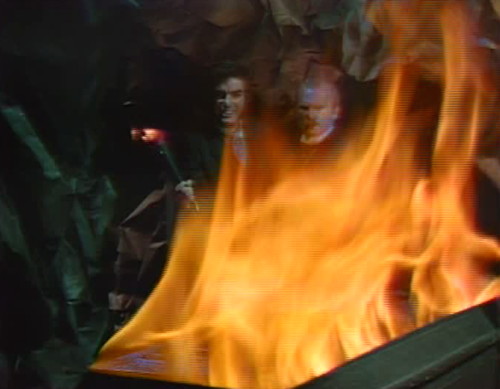
There is actually a third Barnabas, the one in the chained coffin in the secret room in the mausoleum which Willie will release in 1967. When Edward threw the wands on the table preventing astral Barnabas from going to 1969, the 1969 body of Barnabas rejoined his astral self in 1897 while the I Ching returned the 1897 body back to the mausoleum to the chained coffin. It righted the scenario from where Barnabas took over it. At least, that’s how I deal with that.
And they cured his 1969 body in 1897. Only way my head’s ever been able to wrap around it, too. 😀
“This week, in schoolyards across the country, there’s basically one topic of conversation — is Barnabas alive or not? ” I can vouch for the fact that this was happening at Glenburn Elementary school, just outside Bangor, Me. Yes, that Bangor. We thought it was the coolest to be from Maine because of the show. I and my friends would actually improvise scenarios from the show around this time as a way of filling in the blanks evident, such as, ” How the heck is Barnabas dead and alive at the same time?!” This DS insanity was also a perfect compliment of the Halloween season. Even the scholastic book club had DS on its mind…..
Alan that is cool you can remember back that far…lol. I cannot remember most of these episodes especially after 1975.
That’s so awesome, Allan!
Ha, ha! I remember it being awesome at the time, David! It really got our imaginations running wild!
But this new Barnabas doesn’t look exactly the same; he’s taken the precaution of combing his bangs back. This quantum loophole is discussed in a famous study from Patty Duke University.
Uncle Danny, that is the most brilliant analysis of the eternal conflict between Joshua’s and Trasks, and how it keeps the real world running in the face of the fantastic.
ever so brilliant MELISSA i just had to come and say you made me laugh out loud.
Danny – I can explain how they did the special effect where you saw the two Barnabases. Notice that there’s only one shot where we see Edward, live Baranabas, Quentin/Petofi, and staked Barnabas. Before the taping of that day’s episode began, they pre-recorded the shot with everyone but staked Barnabas. The coffin was really empty. Then, Frid assumed the position of staked Barnabas on a table draped in blue (which was the preferred chromakey color at that time). They rolled the pre-recorded shot and re-recorded it – this time with staked Barnabas being chromakeyed in the spot where his body would have been in the coffin. This second recording probably lasted about 30 seconds. It was later rolled-in to the full episode while it was being taped. That’s why you don’t see any of the actors speaking during that shot. Also, they got Frid to get into the coffin as staked Barnabas and got a shot that they pre-recorded and rolled it in to the scene after the main titles. No actual editing had to be done with this process – just a little extra pre-recording. But I do know for a fact that by this time, electronic editing (instead of splicing) was the industry standard, and we will see more and more of it for some DS special effects.
Danny, please acknowledge that you read this. Thanks.
Robert–I’m not Danny, but thanks for the explanation! A couple things–it looks like they matted both Barnabas AND the coffin over the live action, which would have made lining up the matte a little easier (but still tricky). You can see an obvious (electronic?) when the cave scene starts, which suggests they took a break to line up the special effects.
Both images of Barnabas in the coffin look to me like still shots. Is that possible?
Thanks!
Since the suit the “dead” Barnabas is wearing is different from the grey suit the alive Barnabas is sporting, I think that the Barnabas in the coffin is either a still or was the pre-taped section, rather than the other way ’round.I would go for the still, since it would be easier to use a shot from the original staking eps than to re-rig Frid for a special shot. Also, probably cheaper 🙂 Also, I have run across at least one shot of the staked Barnabas with a blue background…
Cool!
I think we solved it….
What you’re saying seems logical, but at the time was technically impossible. Back then they couldn’t pre-record the shot of dead Barnabas in the coffin and then chromakey the other shot over it. That is, you couldn’t tape an actor in front of the blue background and then play that tape back and remove all the blue over a live shot. It can be done now with our advance technology, but not back then.
Of course, dead Barnabas could have been played by a wax dummy…
Gurlitt – You are correct. I watched it again and dead Barnabas was in the coffin and they chromakeyed that over the wide shot with the others.
I meant to type, “You can see an obvious (electronic?) edit when the cave scene starts.”
There could have been an edit, but I don’t think the did that. They cut to the videotaped footage as they were doing the show rather than having to go back and edit later. Sometimes – especially back in those times – the video glitches a little bit because they were cutting from a live camera to a videotape rolling in progress. In this case it almost did look like a still frame, but I looked closely and live Barnabas did move a bit. I don’t mean to sound like a know-it-all, but in this case, I do have my experiences in working in TV production and post production in the ’70s. I much prefer what we can do today digitally; I can do all kinds of post production effects on my computer that took a lot of time to do back then! Still, it was a fun era.
Hey, you know way more than me! I greatly appreciate the info, because I’ve been curious about DS’s effects forever. Or, at least, since I first watched the show back in the day.
At the risk of asking a dumb question, was there literally a switch for going between live and pre-recorded input? I’m picturing a toggle switch labeled, “Live/Tape”! But it likely wasn’t that simple….
It occurs to me that the 1966 scene of Josette strolling out of her painting in the Old House could have been pre-taped and rolled in. Or did they have the means at that point?
Thanks for sharing your knowledge….
Yes, there is a switch. Actually, there are lots of switches. The technical director sits behind a switcher -that’s actually the industry name for it. It looks like a desk but with rows and rows of buttons. This is how they switch from camera 1 to camera 2 and camera 3. There is a button for the film chain, which is where the slides of Collinwood and the Old House are placed in a carousel. There are buttons for the tape machines. Back in those days, tape machines were called VTRs (videotape recorders). So the tech director can cut between any of these video sources (cameras, slides, film, and videotape). The row of buttons is called a bank. Simple switchers had two banks with a fader bar (more like a lever). So if you had the lever closer to Bank A, that was what was going out over the air or being recorded. If you move the lever to Bank B, the video dissolves to whatever button is selected on Bank B.
Now study hard, because there will be a test on this on Friday! LOL.
If it was done live rather than photographically, then Frid had to do a complete costume change in under two minutes, including removal of prop stake, etc.
Actually, the 869 intro was taped from the episode before, 868, and there was virtually no time for Frid to get into the coffin in another outfit from the scene before. I suppose Frid could have been rolled in after initial taping to have his shot “live,” but wouldn’t that be a dreaded and mostly avoided edit? How is a ChromaKey effect inserted into a taped scene, but not the other way round? Thanks.
Okay. Here’s how I think it was done. Step 1. They videotaped the wide shot with Edward, live Barnabas, and Quentin/Petofi. There was no coffin in the shot so that it could be chroma keyed in the next step. They got about 30 seconds of the shot with no one talking. Then they stopped tape. Step 2. Frid changed his wardrobe to play the dead Barnabas. He came onto the chromakey set – nothing but blue background and blue material on the floor. The coffin was in the shot and Frid assumed the position of dead Barnabas in the coffin with blue all around him and the coffin. Then the director had the tape operations person rewind the previously recorded wide shot from step 1, and cue it. She then had the tape person record on another tape with another videotape machine while at the same time, playing the tape of the shot from step 1. Through the switcher, the chromakey effect was set up so that dead Barnabas was being chromakeyed over the videotape playing footage from step 1. After about 30 seconds, the director says “cut,” and the tape operations person stops both videotape machines. Then Frid is freed to get back into his “live Barnabas” costume. Step 3. When the entire show is being shot, when the shot with Edward, live Barnabas, Quentin/Petofi and dead Barnabas is needed, the director cues the videotape operations person to play the tape with the completed shot from step 2. The director then tells the technical director when to cut to the pre-recorded taped shot from Step 2. They keep this shot up for a few seconds and then cut back to the actors reacting. Now, can someone please buy me a beer after explaining all of this? LOL!
Yes! The beer’s on me. Thanks for figuring all of this out!
As gurlitt said, there’s also a still shot of staked Barnabas a few seconds later. After they do the Chromakey effect and Barnabas collapses on the floor, Edward looks down at the coffin, and they cut to a still — that’s the image that I used for the header image at the top of the post.
The second shot is indeed a still shot. This was simply a case of getting a medium close-up shot of dead Barnabas in the coffin and using what is called a frame storer. They got the the right after completing the chromakey bit earlier. They simply cut to the frame stored shot during episode taping instead of going back and editing later.
Thanks!
My pleasure – I love talking about this stuff. Now, are you ready for your test? LOL.
Great dialogue in this episode — almost worthy of Sam Hall and Violet Welles. The chemistry between Trask, Edward, and Quentin (even when he’s Petofi) is great and feels like an otherwise “normal” soap opera. This is a sort of grounding in reality that the modern-day Collins family never provided after Jason McGuire’s death.
The modern day family does return to a little bit of that grounding, don’t they, at the start of the Leviathan storyline? For two or three really wonderful episodes it’s all about Elizabeth and Roger and Carolyn again, emotionally responding to the return of Paul Stoddard. Joan Bennett has a great scene with Dennis Patrick at the inn, I believe. It’s disappointing when Elizabeth goes Leviathan and doesn’t care about Paul anymore. But Nancy Barrett gets to play some real human emotions again in the course of those eoisodes.
I totally agree, Will. I had such a sense of relief when they returned to the present from 1795 and 1897. Why they had to go so over the top with zombies everywhere later on during the Leviathan plot is beyond me.
Yes, Paul Stoddard unfortunately winds up being part of the Leviathan plot, rather than stumbling onto it, which I might have preferred.
No matter whom he’s playing, Louis Edmonds’s special power is bringing everything back to reality.
In today’s episode, I appreciated the moment when Pansy/Charity mock-mooned Trask on the foyer stairs as part of her chorus girl bit. Ha ha, take that jerk!
Dostoevsky was a big deal in the USA during the Cold War, so I wonder if his short novel THE DOUBLE was an inspiration for the writers when they were coming up with Barnabas’ cover story. Conrad’s “Secret Sharer” was prominent in the same years, and doppelgänger stories featured on shows like “The Twilight Zone,” “Alfred Hitchcock Presents,” and “Star Trek.” So there were lots of sources the fabled “Den of Thieves” could use, and lots of viewers who would find it plausible that Edward and Judith would accept Barnabas’ story.
It’s interesting that Edward is following the pattern of Louis Edmonds’ other two characters, Roger and Joshua. Each starts out as a buffoonish blowhard but gradually mellows into a man of greater depth, becoming in the process sympathetic if not exactly likable.
“Schrödinger just starts smacking at the cat with his briefcase, desperately trying to get it to resolve into one state or another.”
I laughed so hard at that! I love Danny trying to reconcile quantum mechanics with Dark Shadows.
This double Barnabas storyline is awesome! And even better is everyone being done with Trask’s shit! Edward can’t even with his buffoonery! I love it!
The cave set looks like it was borrowed from an elementary school production where the cave rocks were made from gray butcher paper that has been bunched up. I think it speaks to the actor’s ability to be so serious about this insanity in the scripts.
This same evening ABC aired Bewitched episode #176: “Naming Samantha’s New Baby” where Samantha’s father Maurice is furious that her new baby son is going to be named after Darrin’s father Frank. However, he ends up being named Adam.
The cave is BROWN CRAFT PAPER bunched up on chicken wire, I’ll have you know!😜 Sections of this were first used in 1968 as the base of Widow’s Hill, when Willie and BC are looking for Adam. That they saved it from then speaks to the foresight(?) and more to the “thrift” of DCP. Cool coincidence in the Bewitched story!
LOL Thank you for confirming the craft paper. I love that they were so resourceful!
“Even I don’t understand the dead cat.” – A Serious Man
I love Pansy’s trolling of Trask.
I don’t understand this Amanda Harris subplot and Charity’s connection.
Now I don’t have the benefit of knowing what’s coming next – this is my first go through the series – so maybe this is foolish of me, but I think I’m on Edward’s side here. He’s seen two Barnabases in the same place, it seems fairly logical to believe they are different people. Seems a little unfair to turf out/abandon/shoot a guy just because he happens to look the same as someone who’s a bit murdery.
If it is some kind of sneaky vampire trick though, I can’t imagine why Bedtime Barnabas would go with such an odd story, using the same name and establishing a connection with Cave Monster Barnabas. He could just give them a new name and backstory and no-one would question the resemblance; it’s worked so far for Kitty and Tate.
Anyway, that’s my position at this point in time. I’m sure there are no weird Friday surprises just around the corner, waiting to make me look like a gullible numpty.
Also, blooper: Edward seems to struggle a bit during his argument with Trask in the foyer. He finally ends the discussion with what sounds like “if he leaves this house, it’ll be on J-Judith’s daughters, and not yours!”